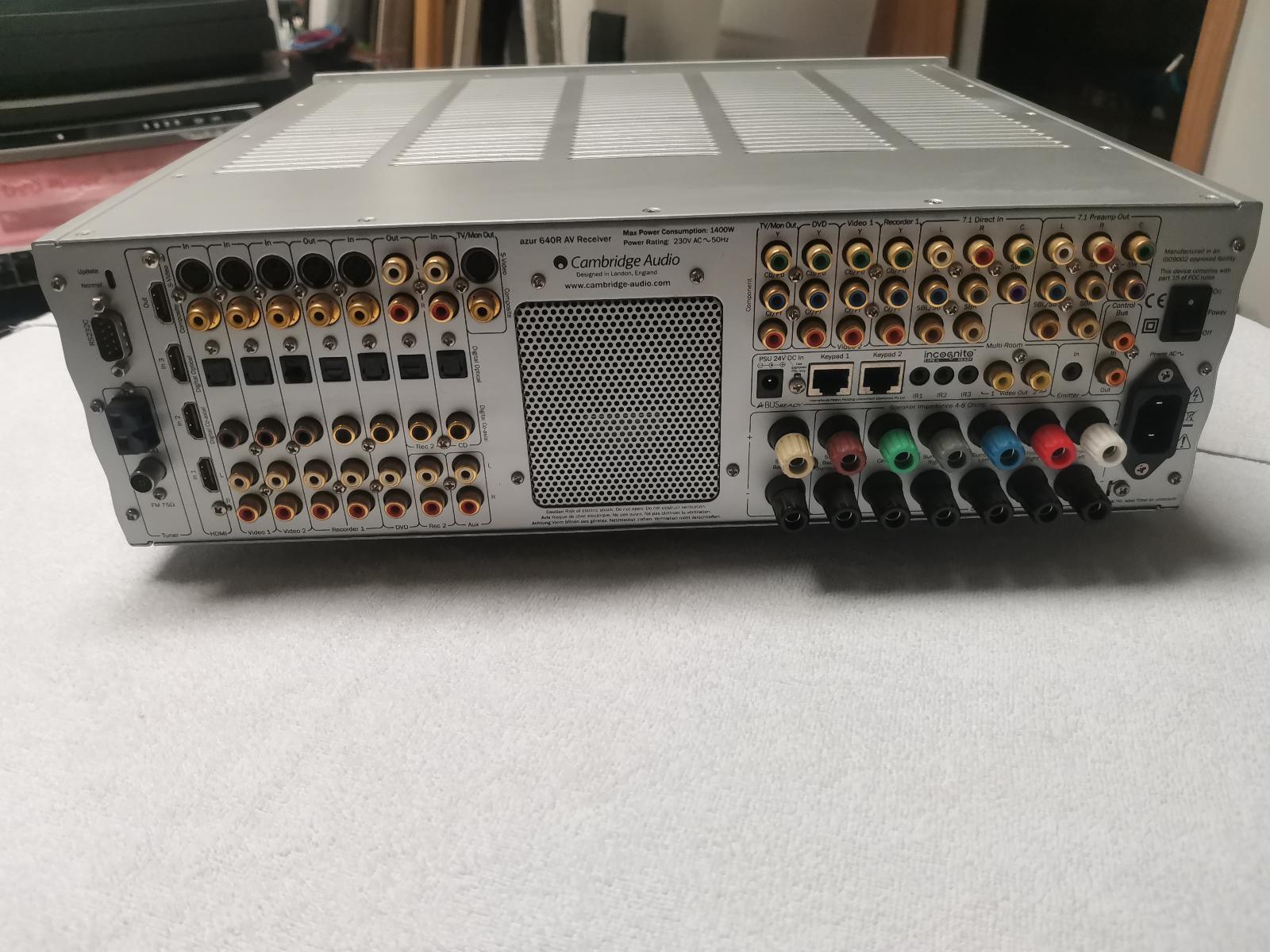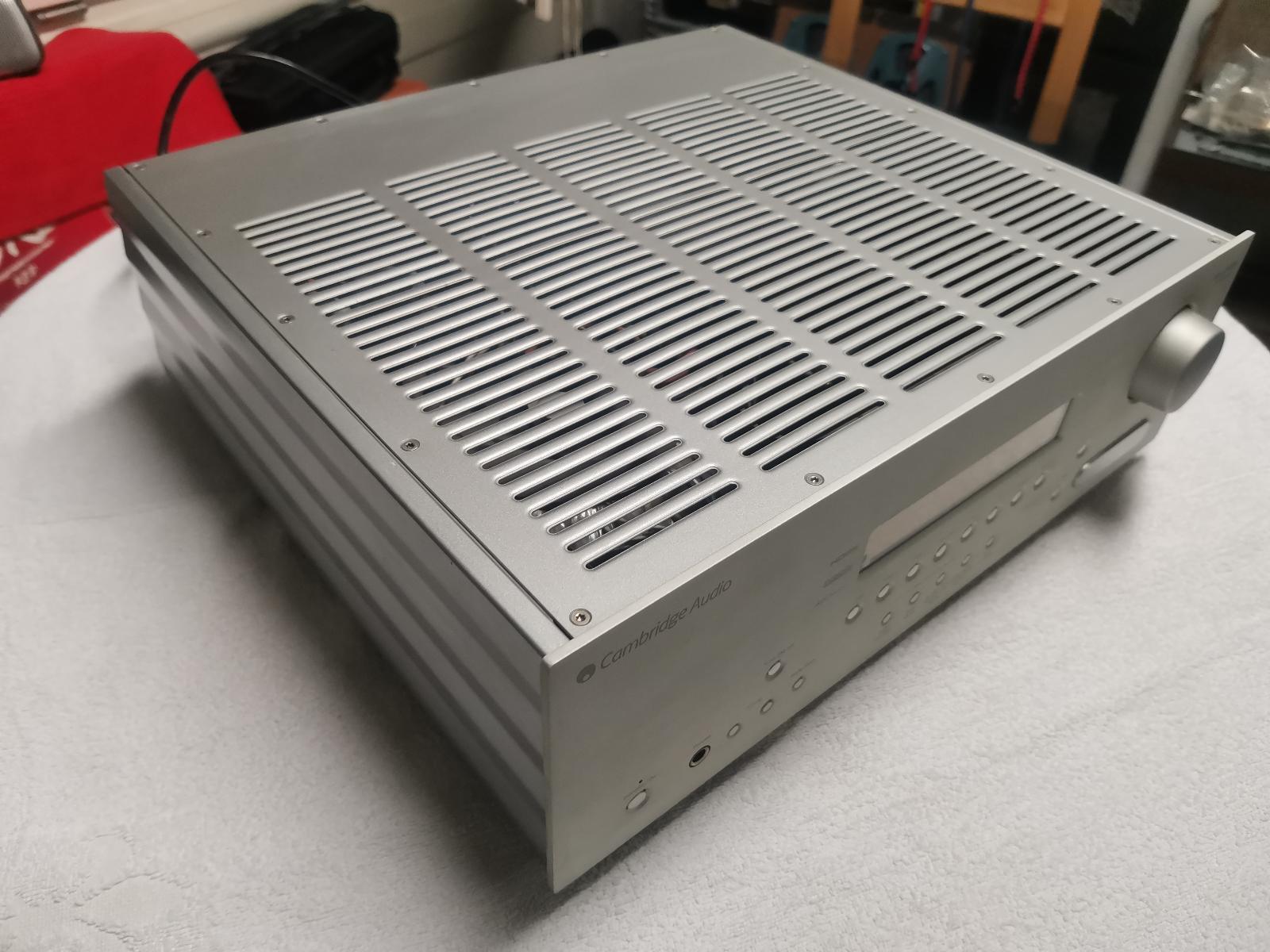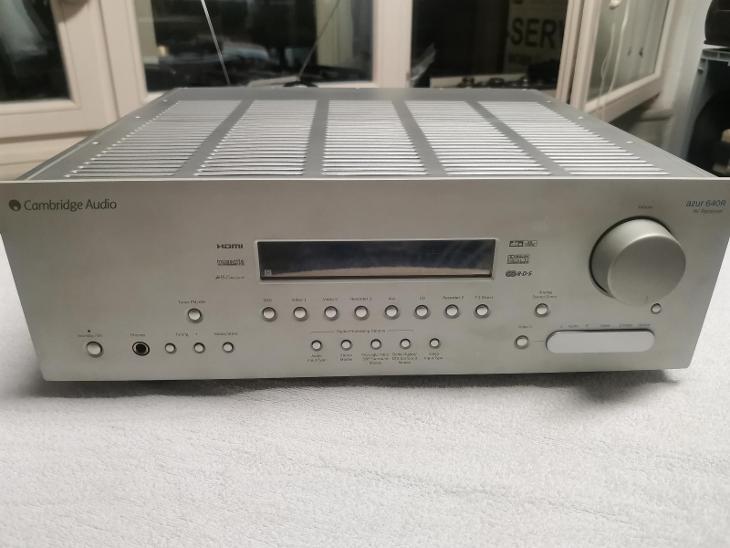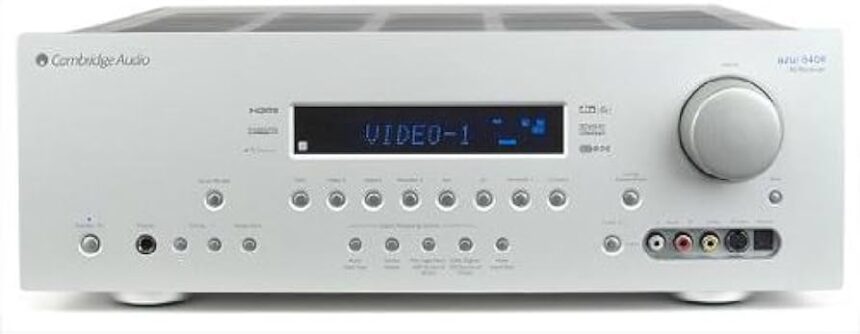Description
The Azur 640R lacks the drop-dead-gorgeous looks of a luxurious high-end component, but I find its sturdy, no-nonsense appearance preferable to the shiny-plastic look of most mass-market receivers. In fact, the 640R is quite striking, with its silver finish, thick aluminum faceplate, and round metal pushbuttons. Like other Cambridge products, it’s also available in black, but I think silver looks classier, and sets it apart from the ubiquitous black of A/V gear.

The 640R has all the requisite inputs and outputs required for it to be used as the hub of a comprehensive home-theater system. There are three complete sets of audio/video inputs comprising S-video, composite video, analog stereo, and coaxial and optical digital. A similarly equipped tape loop (including digital outputs) is provided, along with an audio-only recording output and auxiliary input. On the front panel, an additional set of inputs lacks only coaxial digital. There are three sets of component-video inputs and three assignable HDMI inputs. The direct analog audio input has a full 7.1 channels, as do the corresponding preamp outputs.
Video outputs consist of one each for HDMI, component, S-video, and composite. A variety of outputs compatible with Cambridge’s proprietary Incognito multiroom system, as well as an RS-232 port, are also included. The speaker terminals are relatively sturdy binding posts similar to those found on most other midpriced receivers. There is a headphone jack, and the power cord is removable.
The Azur 640R can transcode analog video signals from composite to S-video to component. Unfortunately, it can’t transcode these signals into HDMI digital video signals, nor can it receive audio signals through its HDMI inputs. It simply acts as a switching device for HDMI signals. This is not entirely unexpected; receivers made by some other manufacturers, such as Arcam, also provide only switching for the HDMI inputs.

Decoding of all the expected surround formats is provided (see “Features”), with up to 7.1 channels of output. Cambridge claims the 640R’s power output to be 120Wpc into 8 ohms, two channels driven, or 100Wpc into 8 ohms, all channels driven. A large vent in the center of the rear panel is part of Cambridge’s X-Tract Forced/Convection Heat Tunnel. The metal Tunnel draws heat away from the transformer and output stages by a combination of natural convection and forced air. During conditions of extreme heat, a variable-speed, “near-silent” fan is activated. This fan either was never required, or was in fact “near-silent” — I never heard it once during the entire review period. For those who care about such things (I am one of them), a massive toroidal transformer is visible through the top vents.
The remote control is slim. Except for volume control, which is handled by the four-way navigation button, the many small, indistinguishable buttons make the remote somewhat difficult to use. However, it has an attractive metal top plate and a nice sturdy feel. Other features include an AM/FM (RDS) tuner, tone controls and an Audio Split mode that allows you to watch and listen to different sources.
Setup
I installed the Azur 640R in my usual home-theater setup: Oppo DV-970HD DVD player, Paradigm Reference Signature C3 center and Reference Signature S8 L/R speakers up front, Mirage Omni 260s as the surrounds, and a Paradigm Reference Servo-15 v.2 subwoofer. Speaker cables and interconnects were by Analysis Plus, and I plugged everything but the sub into a Zero Surge 1MOD15WI surge suppressor with ESP and Shunyata Research AC cords. Although it wasn’t necessary, I ran the HDMI video signal from the disc player through the 640R and, as expected, noticed no loss of picture quality.

The Azur 640R was incredibly easy to set up. The onscreen display is straightforward, without a lot of menus for extraneous features, though a few features I would have liked to have seen were missing. The first is the ability to set the crossover frequency separately for each speaker type. Speakers can be set as Large or Small; the crossover frequency is adjustable from 40 to 200Hz, but the setting is then applied to all speakers. I would have also liked the ability to set the center-channel distance greater than that of the mains. Whatever the distance to the mains, that was the maximum distance allowed for the center channel. Another quirk was that distances were measured in 0.34-meter increments, presumably because this is equivalent to a 1-millisecond delay, as stated in the manual.
Listening
My experience with Cambridge Audio’s excellent-sounding Azur 540D DVD-Audio player and surround receivers from other specialty audio manufacturers led me to expect a lot from the Azur 640R, and I wasn’t disappointed. From the very beginning, it was a pleasure to listen to both movie soundtracks and music. Even at high volumes, I heard little of the harshness and lack of control that I associate with lesser receivers.

The DTS soundtrack of Snakes on a Plane sounded excellent through the 640R. The opening off-road motorcycle sequence has some impressive sound effects and an enveloping music score to go along with the sweeping visuals. The wonderful sound design continues throughout the film, though there is less music and more loud crashes and other effects as the snakes wreak their havoc. Thunder sounded foreboding and frightening as it emanated from the surround channels. It was easy to discern that it was off in the distance at first, then closer as the action heightened.
An action film with a more prominent music score is Top Gun: Special Collector’s Edition. Although now remastered in DTS-ES Discrete 6.1, this 21-year-old soundtrack is showing its age. Even so, the 640R was able to keep the music and many effects well separated. The sound of jet afterburners in the surrounds was easily distinguishable from the prominent percussion in the synthesizer-laden soundtrack. Although I’m a bit ashamed to admit it, I enjoyed listening to this soundtrack immensely through the 640R. I even found myself repeatedly watching scenes featuring Kenny Loggins’ “Danger Zone,” which really got my pulse pounding.
Listening to multichannel music DVDs through the 640R, I was impressed by how clean and clear everything sounded. “Good Vibrations,” from An All-Star Tribute to Brian Wilson, features the vocals of Ann and Nancy Wilson, Jubilant Sykes, the Boys Choir of Harlem, and the backing of Wilson’s band, the Wondermints. Sykes’ vocals sounded especially smooth and natural, as did the harmonizing of Carly Simon, David Crosby, and Jimmy Webb on “In My Room.” When Alison Krauss and Union Station got things going with “Choctaw Hayride,” from Alison Krauss + Union Station Live, the 640R kept up the foot-stomping beat without hesitation. The explosive sound of Jerry Douglas’s dobro and Krauss’s slamming fiddle had wonderful dynamic range, giving them a lively, realistic sound. The melodies on “Baby, Now That I’ve Found You” were smooth and flowing, as were Krauss’s closely miked vocals.
The Azur 640R was also adept at playing stereo recordings. It captured the subtleties of Neil Young’s voice and solo acoustic piano on “Heart of Gold,” from the 24-bit/96kHz version of his Live at Massey Hall, even though they’re recorded at a level that is sometimes barely audible. His mournful vocal on “See the Sky About to Rain” was placed palpably in the middle of my listening room, with a good sense of depth that gave me goose bumps. Again, the 640R sounded remarkably clear and powerful, but this time it was with two-channel music. There was plenty of body, but it never sounded too warm or lush. With speakers priced in line with the 640R, such as the Athena AS-B1 or Mirage Omni 260, the sound was always coherent and satisfying. When the 640R was pushed hard, I heard some glare through the extremely revealing Paradigm Reference Signature S8s and C3, but I would never have noticed this had I not used the 640R with such highly resolving speakers.

Comparison
The Cambridge Audio Azur 640R did not have the absolute authority or finesse of my reference Anthem Statement D2 preamplifier-processor ($6699) and Bel Canto e.One REF1000 monoblocks ($4000/pair) and eVo6 power amp ($4900, discontinued), but it wasn’t noticeably lacking in any particular area. I thoroughly enjoyed watching movies with the 640R, and never felt the urge to switch back to my reference system during the review period. The Azur’s imaging and retrieval of detail were particularly impressive. In Kill Bill: Volume 1, during the sword fight between Lucy Liu and Uma Thurman, the clapping and percussion were distinct and placed precisely in the soundstage. The imaging may not have been as precise as with my reference components, but I didn’t feel I was missing anything. Sometimes I did think that loud effects such as explosions, and the roar of jet engines in Top Gun, were a little too jarring, but this is not unusual for many systems with movie soundtracks that are recorded at very high levels. My combination of Anthem and Bel Canto amplification seemed to be able to smooth out such effects without diminishing any of their dynamic range, but this level of performance is usually reserved for only the very best of systems.

Conclusion
These days, for $1000 or even less, you can buy a receiver with full HDMI connectivity, auto-equalization, and comprehensive bass management, as well as a lot of features you’d probably never use. But I’m usually not satisfied with the sound of such receivers with both movies and music. Six years ago, I reviewed a midpriced surround receiver from a specialty audio manufacturer, and what I said then holds true today: Smaller audio manufacturers may not be able to provide the most up-to-date feature sets offered in some of the latest receivers from huge consumer-electronics firms, but they typically offer better sound.
Such was the case with the well-built and exceptional-sounding Cambridge Audio Azur 640R. It provided first-rate sound with movie soundtracks, as well as very good playback of two-channel music recordings that satisfied the audiophile in me. At $1399, it costs more than many of those other receivers, but I think the step up in audio performance is worth it. If I were spending my own money, this is exactly the kind of product I would buy.
Azur 640R features
- HDMI switching allows latest DVD players and set-top boxes to be routed to the TV
- 32-bit DSP, 24/192 capable DACS
- Power output of 7 x 100 watts rms per channel, 8 ohms (all channels driven)
- Analogue video up-conversion (transcode composite to s-video, s-video to component)
- HDTV capable via component video or HDMI / DVI
- Dolby Digital and DTS formats in 5.1, 6.1 and 7.1 supported
- Dolby Pro Logic® II or IIx and DTS Neo:6 decoded in 5.1, 6.1 and 7.1
- Post processing of 5.1 or 6.1 digital material with PLIIx or DTS Neo:6 to turn these formats into full 7.1
- 5.1, 6.1 and 7.1 analogue input for connection of a DVD Audio or SACD players
- On Screen Display (OSD)
- A-BUS™ Ready/Incognito Ready™ multi-room outputs
- RS232 port, IR emitter In, Control Bus In/Out
- Audio Split mode to watch and listen to different sources
Reviewer: Roger Kanno







